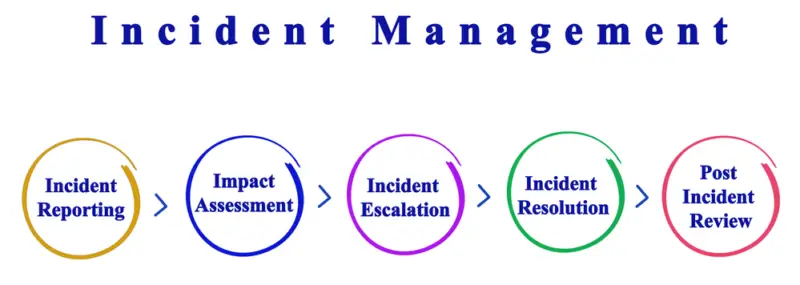Importance of efficient incident management systems
In the fast-paced and ever-evolving world of risk management, professional risk practitioners understand the critical role of efficient incident management systems. When effectively addressing and resolving incidents, having the right tools and processes in place can mean distinguishing between a minor hiccup and a major crisis.
Imagine an organisation encountering a security breach or a critical system failure. Without a well-structured incident management system, chaos can ensue, causing delays in response, miscommunication among teams, and a lack of accountability.
This can lead to a snowball effect, exacerbating the impact of the incident and resulting in potential financial losses, reputational damage, and regulatory non-compliance.
To mitigate these risks, professional risk practitioners recognize the imperative of implementing efficient incident management systems.
These systems provide a structured approach to incident resolution, ensuring incidents are promptly identified, categorized, and addressed systematically.
Organizations can optimize their incident management processes and reduce the impact of disruptions by utilizing technology and implementing best practices.
An efficient incident management system enables organizations to respond swiftly, collaborate effectively, and document incidents thoroughly.
In the following sections, we will delve deeper into the world of incident management systems, exploring their definition, benefits, key features, and considerations for implementation.
Whether you are a seasoned risk practitioner or new to the field, this article will equip you with the knowledge and insights needed to navigate the complex landscape of incident management and empower you to make informed decisions for your organization’s resilience.
Stay tuned as we embark on this journey to unravel the intricacies of incident management and discover how it can transform how organizations handle disruptions.

What is an Incident Management System
Definition and Overview
In the world of risk management, incidents are inevitable. Whether it’s an unexpected system outage, a security breach, or a workplace accident, organizations need a reliable and efficient system to promptly address and resolve these incidents. This is where an Incident Management System (IMS) comes into play.
An IMS is a comprehensive framework that enables organizations to effectively handle and respond to incidents, ensuring minimal disruption to operations and mitigating potential risks. It serves as a centralized platform that brings together people, processes, and technology, allowing for swift incident resolution and proactive prevention of future occurrences.
At its core, an IMS is designed to streamline the incident management process, enabling organizations to detect, assess, and resolve incidents systematically and organised.
It provides a structured approach that helps professional risk practitioners identify the root causes of incidents, implement appropriate countermeasures, and ultimately enhance the overall resilience of their operations.
The primary goal of an IMS is to minimize the impact of incidents on an organization’s operations, reputation, and bottom line. By implementing an effective IMS, organizations can ensure a swift response, efficient communication, and seamless collaboration among their incident management team.
This enables them to address incidents promptly, minimize downtime, and prevent potential escalation into major crises.
Moreover, an IMS facilitates the collection and documentation of critical incident data, providing valuable insights for future analysis and continuous improvement. It allows organizations to track incident trends, identify recurring issues, and implement preventive measures to reduce the likelihood of similar incidents occurring in the future.
An IMS is vital for any organization serious about managing incidents effectively. It empowers risk practitioners to respond swiftly and confidently to various incidents, ensuring business continuity and safeguarding the organization’s reputation.
In the following sections, we will delve deeper into the benefits of implementing an efficient IMS and explore the key features that make it an indispensable asset for any organization.
Continue reading about the benefits of an efficient Incident Management System.
Benefits of an Efficient Incident Management System
Improved Response Time
When it comes to managing incidents effectively, improved response time is crucial. Time is of the essence in any incident, and a delay in response can lead to further escalation and potential damage.
An efficient incident management system enables the swift identification and prompt resolution of incidents, minimizing the impact on business operations.
With an organized and automated system, incidents can be triaged and prioritized based on their severity and urgency.
This ensures that the right resources are allocated promptly, allowing quicker response and resolution. By reducing response time, organizations can mitigate the potential negative consequences of incidents on their operations.
Enhanced Communication
In the fast-paced world of incident management, effective communication is paramount. An efficient incident management system facilitates enhanced communication among all stakeholders involved in the incident resolution process.
Clear and timely communication ensures everyone is on the same page, minimizing miscommunications and misunderstandings. The system sends real-time updates and notifications to the respective teams, informing them of the incident status and any developments.
Moreover, a robust incident management system promotes collaboration among different teams and departments, fostering a unified approach to incident resolution.
Organizations can streamline the incident management process and enhance their overall response capabilities by enabling seamless communication.
Better Documentation and Reporting
Accurate and comprehensive documentation is essential for effective incident management. An efficient incident management system provides a centralized platform for better documentation and reporting.
Incident details, including timestamps, relevant information, and actions taken, can be recorded and easily accessed through the system. This ensures all critical information is documented, creating a valuable knowledge base for future reference and learning.
Additionally, incident reports generated by the system offer insights into incident trends, patterns, and root causes. These reports enable organizations to identify recurring issues and implement proactive measures to prevent similar incidents from occurring in the future.
Streamlined Workflow
A well-designed incident management system contributes to a streamlined workflow by automating and optimizing various processes. By eliminating manual and time-consuming tasks, organizations can allocate their resources more efficiently and focus on resolving incidents promptly.
An efficient system facilitates the seamless flow of information and tasks, ensuring that incidents are assigned to the appropriate teams and individuals. This promotes responsiveness, reduces bottlenecks, and facilitates a more agile incident management process.
Moreover, a streamlined workflow enables organizations to adhere to predefined incident management procedures.
Organizations can ensure consistency and minimize errors by following a structured approach, leading to more effective incident resolution.
Cost Savings
Implementing an efficient incident management system can result in significant cost savings for organizations. Organizations can avoid potential financial losses associated with downtime, service disruptions, or customer dissatisfaction by minimising the impact and duration of incidents.
Furthermore, an efficient system allows organizations to identify and address incidents proactively. By detecting and resolving potential issues before they escalate, organizations can prevent costly incidents from occurring in the first place.
Additionally, the streamlined workflow and improved documentation provided by the system contribute to operational efficiency. This leads to resource optimization and reduced operational costs in the long run.
An efficient incident management system offers a range of benefits to organizations. From improved response time to enhanced communication, better documentation and reporting, streamlined workflow, and cost savings, organizations can gain a competitive edge by implementing the right incident management system.
Organizations can effectively handle incidents and minimize their impact on business operations by choosing a system that aligns with their needs and requirements.
Key Features of an Effective Incident Management System
Regarding incident management, having the right tools and systems in place can make all the difference. An efficient incident management system is crucial for professional risk practitioners, as it helps them streamline their processes and effectively respond to any potential incidents that may arise.
This section will explore the key features of an effective incident management system that can help organizations stay prepared and minimize the impact of unexpected events.
Incident Reporting
The first step in incident management is the ability to quickly and accurately report incidents as they occur. An efficient incident management system provides a user-friendly interface that allows users to log incidents easily, capturing all the necessary details in a structured and organized manner.
This feature ensures that no incident goes unnoticed and enables the incident management team to initiate the necessary actions promptly.
Incident Categorization and Prioritization
Once an incident is reported, it is important to categorize and prioritize it based on its severity and potential impact. An effective incident management system offers a comprehensive set of predefined incident categories, allowing users to classify incidents accurately.
Additionally, it enables users to assign appropriate priority levels to incidents, ensuring that the most critical issues receive immediate attention.
Proper categorization and prioritization help in efficient resource allocation and enable risk practitioners to address high-priority incidents swiftly.
Escalation and Notification
In incident management, timely escalation and notification are vital in ensuring that incidents are resolved promptly. An efficient incident management system allows for the automatic escalation of incidents based on predefined rules and triggers.
This ensures that incidents are escalated to the appropriate individuals or teams when necessary, minimizing delays in resolution. Furthermore, the system provides real-time notifications to relevant stakeholders, keeping them informed about the status of incidents and facilitating effective communication.
Collaboration and Communication
Collaboration and communication are key components of successful incident management. An effective incident management system fosters collaboration by providing a centralized platform where incident management team members can collaborate in real time.
It enables seamless communication through chat, comments, and file sharing, allowing team members to exchange information and updates effortlessly. This promotes teamwork and enables a coordinated response to incidents, minimizing any potential miscommunication or duplication of efforts.
Incident Tracking and Resolution
Tracking incidents throughout their lifecycle is crucial for effective incident management. An efficient incident system offers robust tracking capabilities, allowing risk practitioners to monitor the progress of incidents from initiation to resolution.
It provides a clear overview of the incident history, including all actions taken and any associated communication. This feature enables practitioners to identify bottlenecks, track response times, and resolve incidents within the defined service level agreements (SLAs).
Analytics and Reporting
To continuously improve incident management processes, data-driven insights are essential. An effective incident management system provides comprehensive analytics and reporting capabilities to help risk practitioners gain insights into incident trends, response times, and resolution rates.
With customizable dashboards and reports, practitioners can analyze data, identify patterns, and make informed decisions to enhance their incident management strategies. These insights also serve as valuable inputs for risk assessments and process improvements.
Incorporating these key features into an incident management system can significantly enhance an organization’s incident response capabilities.
Risk practitioners can effectively mitigate risks and minimise the impact of incidents on their operations by ensuring efficient incident reporting, categorization, escalation, collaboration, tracking, and analysis.
Choosing the right incident management system that aligns with an organization’s specific needs and requirements is critical to building a resilient incident management framework.
Continue reading to learn more about incident management tools and their importance in incident response.
Choosing the Right Incident Management System
When selecting the most suitable incident management system for your organization, taking a thoughtful and strategic approach is essential.
The right system can significantly impact your ability to respond to incidents and minimize their impact effectively. Here are some key factors to consider when making your decision:

Assessing Your Needs and Requirements
Before diving into the world of incident management systems, assessing your organization’s unique needs and requirements is crucial.
Consider the size of your organization, the complexity of your operations, and the nature of the incidents you typically encounter. This assessment will help you identify the specific features and functionalities crucial for your incident management system.
Evaluating Features and Functionality
An effective incident system should offer a comprehensive suite of features and functionalities that align with your organization’s requirements.
These features may include incident reporting, categorization, prioritization, escalation and notification, collaboration and communication, incident tracking and resolution, analytics and reporting. Evaluate each system’s capabilities in these areas to meet your needs.
Considering Integration Capabilities
To streamline your incident process, it’s essential to consider the integration capabilities of the system you choose.
The ability to seamlessly integrate with other critical systems and tools, such as your incident management team, incident management process, and incident management tools, can enhance efficiency and effectiveness. Look for a system that offers flexible integration options to maximize the benefits.
Scalability and Customizability
As your organization grows and evolves, so do your incident needs. Therefore, it’s important to select a system that can scale with your organization.
Consider the system’s ability to handle many incidents, users, and data. Additionally, look for a solution that allows for customization, enabling you to tailor the system to meet your specific workflows and processes.
User-Friendliness
A user-friendly incident system is crucial for smooth adoption and efficient operation. The system should be intuitive and easy to navigate, with clear instructions and minimal training requirements.
A well-designed interface and logical workflow can save time and reduce the risk of errors. Consider the user experience when evaluating different systems to ensure a seamless transition for your team.
Support and Training
Implementing a new incident system requires adequate support and training. Evaluate the level of support the system’s vendor provides, including access to technical assistance and guidance during the implementation process.
Additionally, consider the availability of training resources, such as user manuals, online tutorials, and training sessions, to ensure your team can effectively utilize the system’s capabilities.
To make the best choice for your organization’s incident system, you must conduct a thorough evaluation of your needs, and scrutinize the available features, integration capabilities, scalability, user-friendliness, and support options.
Only then can you make an informed decision? Remember, a well-chosen system can streamline your incident workflow, enhance your response capabilities, and contribute to better risk management practices.
Implementing and Adopting an Incident Management System
Once you have chosen the right incident system for your organization, the next crucial step is to implement and adopt it successfully.
This process requires meticulous planning, comprehensive training, thorough testing, and a commitment to continuous improvement.
Planning and Preparation
This involves engaging key stakeholders, such as the incident management team, to ensure their buy-in and support.
To begin, establish clear objectives for the implementation, outlining what you hope to achieve with the new system. Identify the specific goals you wish to accomplish, whether improving response time, enhancing communication, or streamlining the workflow.
Furthermore, conducting a thorough analysis of your organization’s current processes and workflows is crucial. This assessment will help you identify any existing gaps or inefficiencies that the new incident management system can address.
You can tailor the implementation plan accordingly by understanding your organization’s unique needs and requirements.
Training and Education
Implementing an incident system requires comprehensive training and education for all relevant personnel. This includes the incident management team and other employees who may be involved in the incident management process.
To ensure a smooth transition, provide detailed training sessions that cover all aspects of the new system. This training should include instruction on navigating the system, inputting incident data, escalating issues, and generating reports.
Equipping your employees with the necessary knowledge and skills empowers them to effectively utilize the system and contribute to the overall incident management efforts.
In addition to training, ongoing education is vital to keep everyone up-to-date with the latest features and enhancements of the incident system.
This can be achieved through regular communication channels like newsletters, webinars, or internal forums. By fostering a culture of continuous learning, you ensure that your organization maximizes the system’s benefits.
Testing and Refinement
This step allows you to identify potential issues or glitches and make necessary adjustments to ensure a seamless user experience.
Begin by conducting thorough testing of the system’s functionality and performance. This includes simulating various incident scenarios to evaluate how the system handles different situations. Doing so lets you identify any weaknesses or areas for improvement and address them before going live.
Additionally, consider conducting a pilot phase where a select group of users can test the system in a real-world environment. This allows for valuable feedback and insights that can be used to refine the system further and address any unforeseen challenges.
Continuous Improvement
Implementing an incident system is not a one-time event but an ongoing process. It requires continuous improvement to ensure the system remains effective and aligned with your organization’s evolving needs.
Regularly evaluate the system’s performance and gather user feedback to identify areas where enhancements can be made. This feedback loop allows you to address any issues promptly and implement necessary updates or modifications.
Additionally, stay informed about the latest developments in incident technology and best practices to ensure your system remains up-to-date and aligned with industry standards.
By embracing a continuous improvement mindset, you position your organization to adapt to changing circumstances and optimize your incident management efforts.
In conclusion, the successful implementation of an incident system requires thorough planning, extensive training, strict evaluation, and an unwavering commitment to continual improvement.
To ensure a smooth transition to the new system and enjoy the advantages of upgraded incident response, communication, and workflows, your organization should follow these steps.
However, it’s important to note that successful implementation is just the start. Consistent maintenance and refinement are crucial to maximizing the value of your incident management system.
To learn more about incident management and related topics, check out our blog posts on the incident management team, incident management process, incident management tools, incident management workflow, and major incident management.

Conclusion
In today’s fast-paced world, where risks and uncertainties lurk around every corner, having an efficient incident management system is crucial for any organization. Whether it’s a small business or a large enterprise, effective incident management can mean the difference between a minor hiccup and a major catastrophe.
Throughout this article, we have explored the importance of efficient incident management systems and their benefits. These advantages can significantly impact an organization’s ability to mitigate risks, minimize disruptions, and maintain business continuity.
When considering an incident system, it is essential to evaluate its key features. Incident reporting, categorization and prioritization, escalation and notification, collaboration and communication, incident tracking and resolution, and analytics and reporting, are all crucial components that contribute to an effective system.
Furthermore, organizations must consider several factors when selecting the right incident system. This includes evaluating the system’s integration capabilities, scalability, customizability, user-friendliness, and the level of support and training the vendor provides.
A well-rounded system that meets these criteria will ensure a smooth implementation and adoption process.
Organizations need to focus on planning, preparation, training, education, testing, and continuous improvement to successfully implement and adopt an incident management system.
An efficient incident management system is not just a luxury but a necessity in today’s risk-filled landscape. By embracing the benefits of such a system, organizations can enhance their risk management capabilities, safeguard their reputation, and protect their bottom line. So, take the leap and explore the world of incident management systems – your organization’s resilience depends on it.

Chris Ekai is a Risk Management expert with over 10 years of experience in the field. He has a Master’s(MSc) degree in Risk Management from University of Portsmouth and is a CPA and Finance professional. He currently works as a Content Manager at Risk Publishing, writing about Enterprise Risk Management, Business Continuity Management and Project Management.

